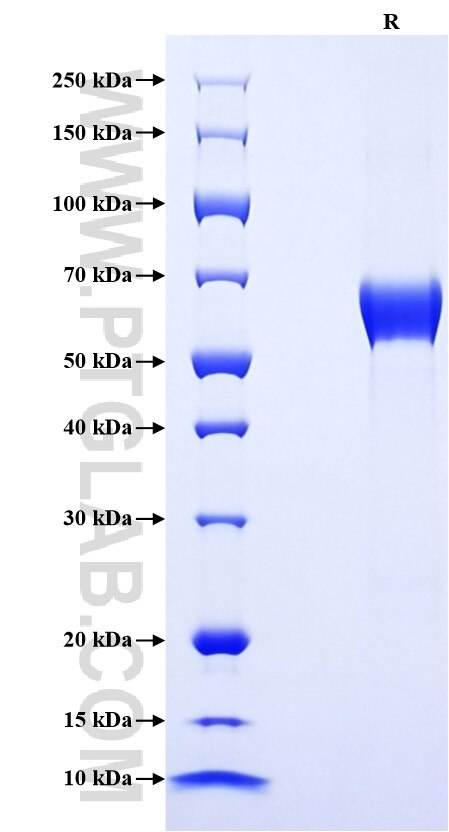Recombinant Mouse CD134/OX40 protein (rFc Tag)
Species
Mouse
Purity
>90 %, SDS-PAGE
Tag
rFc Tag
Activity
not tested
Cat no : Eg2936
Validation Data Gallery
Product Information
| Purity | >90 %, SDS-PAGE |
| Endotoxin | <0.1 EU/μg protein, LAL method |
| Activity |
Not tested |
| Expression | HEK293-derived Mouse CD134 protein Val20-Pro211 (Accession# P47741) with a rabbit IgG Fc tag at the C-terminus. |
| GeneID | 22163 |
| Accession | P47741 |
| PredictedSize | 47.3 kDa |
| SDS-PAGE | 55-70 kDa, reducing (R) conditions |
| Formulation | Lyophilized from 0.22 μm filtered solution in PBS, pH 7.4. Normally 5% trehalose and 5% mannitol are added as protectants before lyophilization. |
| Reconstitution | Briefly centrifuge the tube before opening. Reconstitute at 0.1-0.5 mg/mL in sterile water. |
| Storage Conditions |
It is recommended that the protein be aliquoted for optimal storage. Avoid repeated freeze-thaw cycles.
|
| Shipping | The product is shipped at ambient temperature. Upon receipt, store it immediately at the recommended temperature. |
Background
CD134, also known as OX40 and TNFRSF4, is a member of the TNFR-superfamily of receptors. It is a type I transmembrane protein predominantly expressed on activated T cells which include CD4 and CD8 T cells, Th2, Th1, and Th17 cells, as well as regulatory T cells (Tregs). CD134 is activated by its cognate ligand CD134L (OX40L) and functions as a T cell co-stimulatory molecule. CD134-CD134L interactions have been proposed as a potential therapeutic target for treating autoimmune diseases, cancer and infectious disease.
References:
1. Paterson DJ. et al. (1987) Mol Immunol. 24(12):1281-1290. 2. Roos A. et al. (1998) J Leukoc Biol. 64(4):503-510. 3. Croft M. (2010) Annu Rev Immunol. 28:57-78. 4. Webb GJ. et al. (2016) Clin Rev Allergy Immunol. 50(3):312-332.
